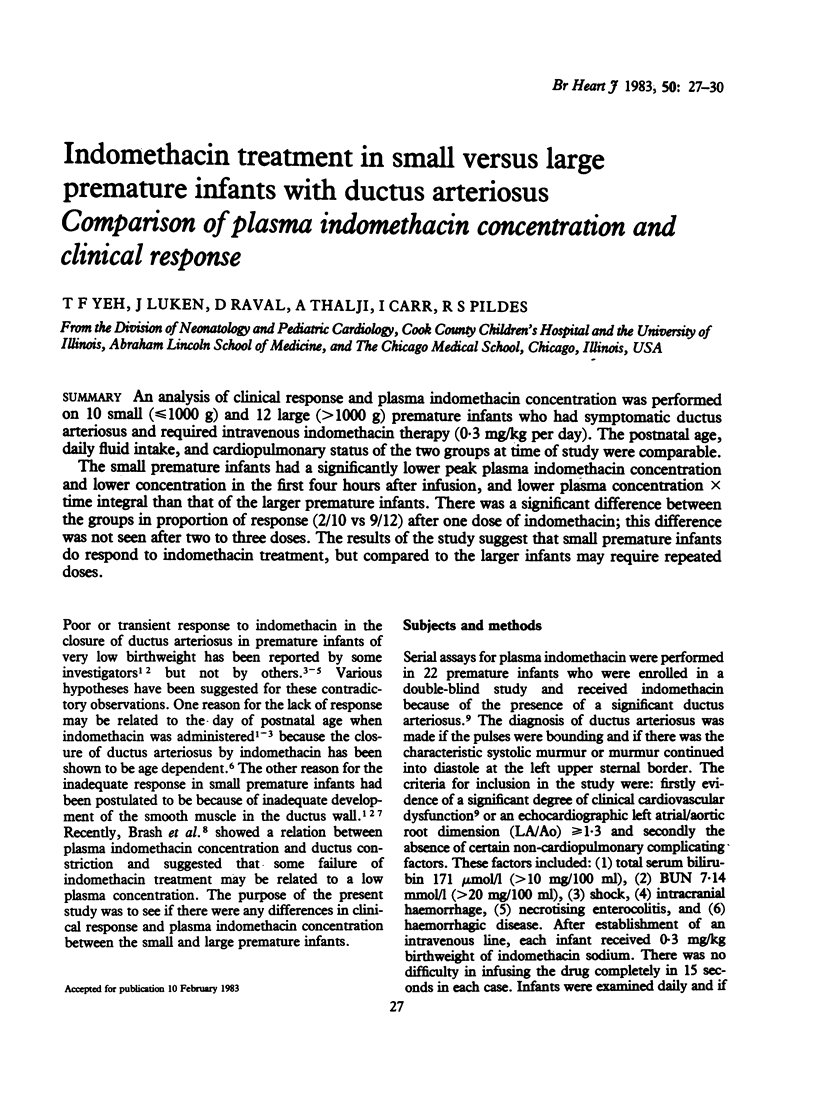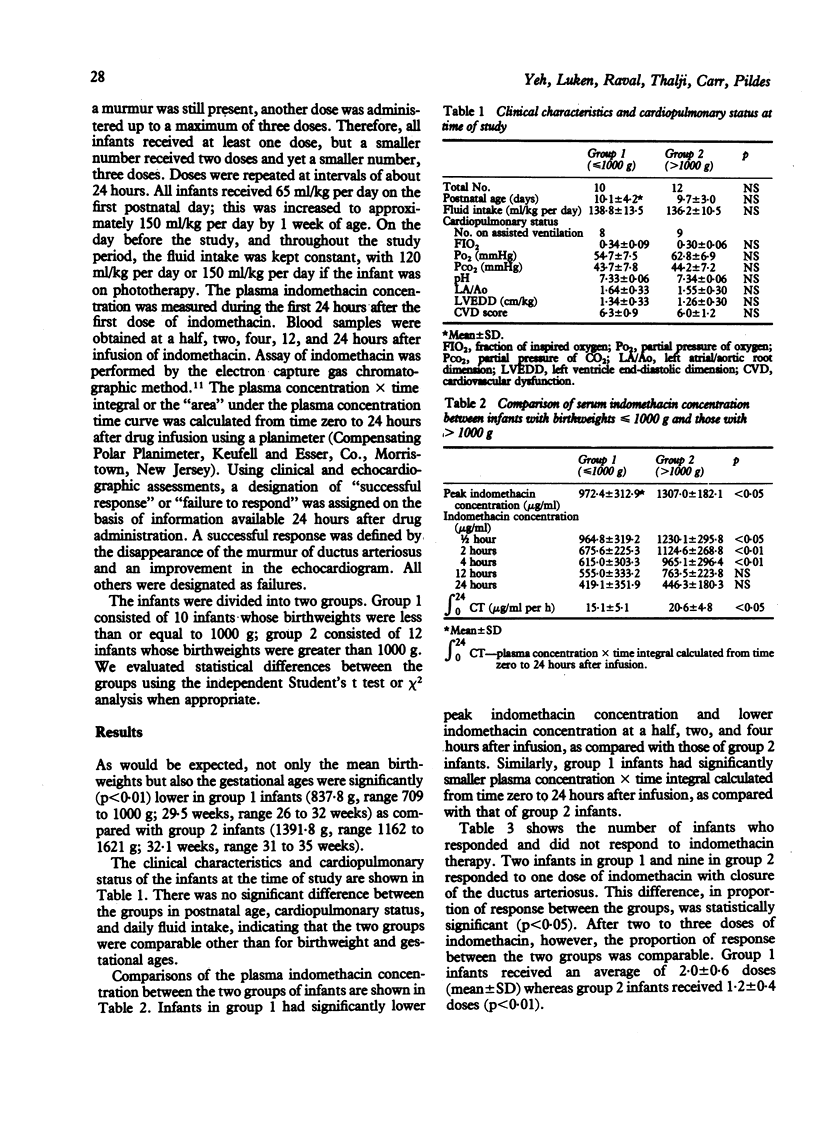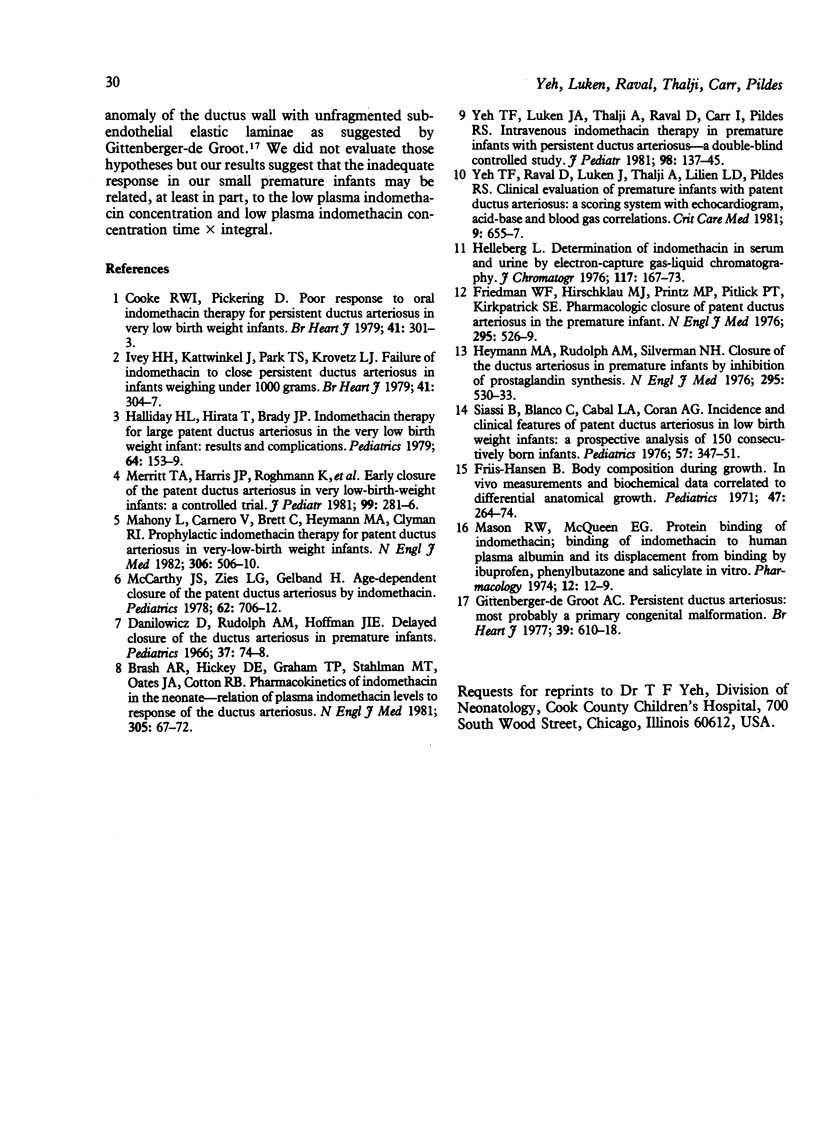Abstract
An analysis of clinical response and plasma indomethacin concentration was performed on 10 small (less than or equal to 1000 g) and 12 large (greater than 1000 g) premature infants who had symptomatic ductus arteriosus and required intravenous indomethacin therapy (0.3 mg/kg per day). The postnatal age, daily fluid intake, and cardiopulmonary status of the two groups at time of study were comparable, The small premature infants had a significantly lower peak plasma indomethacin concentration and lower concentration in the first four hours after infusion, and lower plasma concentration X time integral than that of the larger premature infants. There was a significant difference between the groups in proportion of response (2/10 vs 9/12) after one dose of indomethacin; this difference was not seen after two to three doses. The results of the study suggest that small premature infants do respond to indomethacin treatment, but compared to the larger infants may require repeated doses.
Full text
PDF



Selected References
These references are in PubMed. This may not be the complete list of references from this article.
- Brash A. R., Hickey D. E., Graham T. P., Stahlman M. T., Oates J. A., Cotton R. B. Pharmacokinetics of indomethacin in the neonate. Relation of plasma indomethacin levels to response of the ductus arteriosus. N Engl J Med. 1981 Jul 9;305(2):67–72. doi: 10.1056/NEJM198107093050203. [DOI] [PubMed] [Google Scholar]
- Cooke R. W., Pickering D. Poor response to oral indomethacin therapy for persistent ductus arteriosus in very low birthweight infants. Br Heart J. 1979 Mar;41(3):301–303. doi: 10.1136/hrt.41.3.301. [DOI] [PMC free article] [PubMed] [Google Scholar]
- Danilowicz D., Rudolph A. M., Hoffman J. I. Delayed closure of the ductus arteriosus in premature infants. Pediatrics. 1966 Jan;37(1):74–78. [PubMed] [Google Scholar]
- Friedman W. F., Hirschklau M. J., Printz M. P., Pitlick P. T., Kirkpatrick S. E. Pharmacologic closure of patent ductus arteriosus in the premature infant. N Engl J Med. 1976 Sep 2;295(10):526–529. doi: 10.1056/NEJM197609022951003. [DOI] [PubMed] [Google Scholar]
- Friis-Hansen B. Body composition during growth. In vivo measurements and biochemical data correlated to differential anatomical growth. Pediatrics. 1971 Jan;47(1 Suppl):264+–264+. [PubMed] [Google Scholar]
- Gittenberger-de Groot A. C. Persistent ductus arteriosus: most probably a primary congenital malformation. Br Heart J. 1977 Jun;39(6):610–618. doi: 10.1136/hrt.39.6.610. [DOI] [PMC free article] [PubMed] [Google Scholar]
- Helleberg I. Determination of indomethacin in serum and urine by electron-capture gas-liquid chromatography. J Chromatogr. 1976 Feb 4;117(1):167–173. doi: 10.1016/s0021-9673(00)81078-x. [DOI] [PubMed] [Google Scholar]
- Heymann M. A., Rudolph A. M., Silverman N. H. Closure of the ductus arteriosus in premature infants by inhibition of prostaglandin synthesis. N Engl J Med. 1976 Sep 2;295(10):530–533. doi: 10.1056/NEJM197609022951004. [DOI] [PubMed] [Google Scholar]
- Ivey H. H., Kattwinkel J., Park T. S., Krovetz L. J. Failure of indomethacin to close persistent ductus arteriosus in infants weighing under 1000 grams. Br Heart J. 1979 Mar;41(3):304–307. doi: 10.1136/hrt.41.3.304. [DOI] [PMC free article] [PubMed] [Google Scholar]
- Mahony L., Carnero V., Brett C., Heymann M. A., Clyman R. I. Prophylactic indomethacin therapy for patent ductus arteriosus in very-low-birth-weight infants. N Engl J Med. 1982 Mar 4;306(9):506–510. doi: 10.1056/NEJM198203043060903. [DOI] [PubMed] [Google Scholar]
- Mason R. W., McQueen E. G. Protein binding of indomethacin: binding of indomethacin to human plasma albumin and its displacement from binding by ibuprofen, phenylbutazone and salicylate, in vitro. Pharmacology. 1974;12(1):12–19. doi: 10.1159/000136516. [DOI] [PubMed] [Google Scholar]
- McCarthy J. S., Zies L. G., Gelband H. Age-dependent closure of the patent ductus arteriosus by indomethacin. Pediatrics. 1978 Nov;62(5):706–712. [PubMed] [Google Scholar]
- Merritt T. A., Harris J. P., Roghmann K., Wood B., Campanella V., Alexson C., Manning J., Shapiro D. L. Early closure of the patent ductus arteriosus in very low-birth-weight infants: a controlled trial. J Pediatr. 1981 Aug;99(2):281–286. doi: 10.1016/s0022-3476(81)80479-9. [DOI] [PubMed] [Google Scholar]
- Siassi B., Blanco C., Cabal L. A., Coran A. G. Incidence and clinical features of patent ductus arteriosus in low-birthweight infants: a prospective analysis of 150 consecutively born infants. Pediatrics. 1976 Mar;57(3):347–351. [PubMed] [Google Scholar]
- Yeh T. F., Raval D., Luken J., Thalji A., Lilien L., Pildes R. S. Clinical evaluation of premature infants with patent ductus arteriosus: a scoring system with echocardiogram, acid-base, and blood gas correlations. Crit Care Med. 1981 Sep;9(9):655–657. doi: 10.1097/00003246-198109000-00009. [DOI] [PubMed] [Google Scholar]


